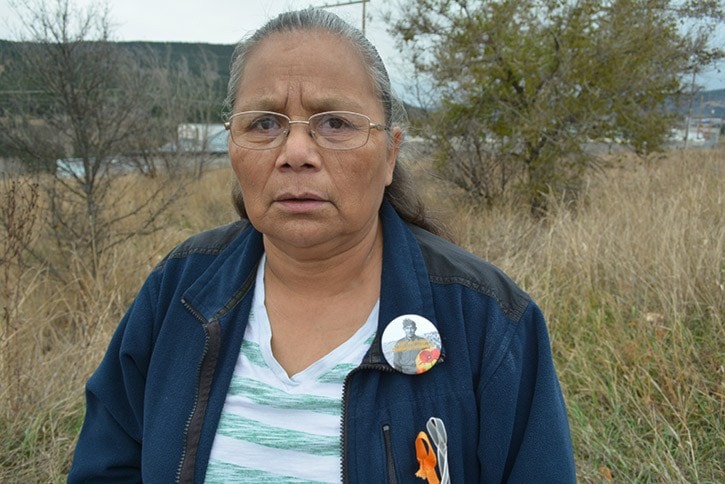Every year members of the Robbins family gather in the graveyard at Esk’et (Alkali Lake) on Remembrance Day to honour Duncan Robbins.
“He fought overseas in the Second World War,” said Edith Robbins, one of his daughters. “He was a sniper, but he didn’t really talk about his experiences with us.”
The Robbins are a large family and when they gather at the graveyard, they go around and drum and sing at all the veterans’ grave sites.
“There are seven or eight of them from our community buried here,” Edith said. “We place a Canadian flag at each grave too.”
And when poppies go on sale, members of the family purchase one each to place on Duncan’s grave too.
Last year, Edith’s daughter Christine decided to take Remembrance Day one step further.
Using an historical photograph of Duncan in uniform that her uncle Basil has in his possession, she had 200 buttons made up featuring Duncan with the words: “Lest We Forget, Duncan Robbins.”

She sent the buttons home to her mom at Esk’et and 150 of them were distributed.
Christine remembers honouring her grandfather when she was a child.
“Even though I live in Vancouver now, I take my daughter to the Squamish Reserve on Remembrance Day every year. It is something everybody in the Robbins family takes part in,” she said.
When Duncan was alive he would dress up too — in his best leather jacket, she added.
In 2011 a new cenotaph was erected at Esk’et.
Fred Robbins, who was chief at the time, placed a brass plate on the newly-built cenotaph with the names of Duncan Robbins, Mabel Belleau, Tony Harry, Adolph Johnson, Francis and Garnet Squinahan and Charlie Sampson.
Edith said her dad said when he was riding in a jeep one time during the war and the jeep rolled over on him.
“He complained about his legs because the roll bar landed on them. He had a scar on his neck too, but I don’t know what it was from,” she recalled.
According to Veterans Affairs Canada, at least 3,000 status (treaty) Indians—including 72 women—enlisted, as well as an unknown number of Inuit, Métis, and other Natives. The actual numbers were no doubt much higher.
Duncan’s name does appear on an Aboriginal Veterans Honour List. However, other than his band and heritage, and the fact he served in the Second World War, under the heading rank/division/unit and regiment, are the letters “tbd.”
When he returned from the war, Duncan worked building fences on various ranches in the Cariboo-Chilcotin.
“Our family moved around to different areas like the Gang Ranch, Lac La Hache or whatever,” Edith said.
Duncan was born on May 2, 1920 and lived until April 5, 2013.

